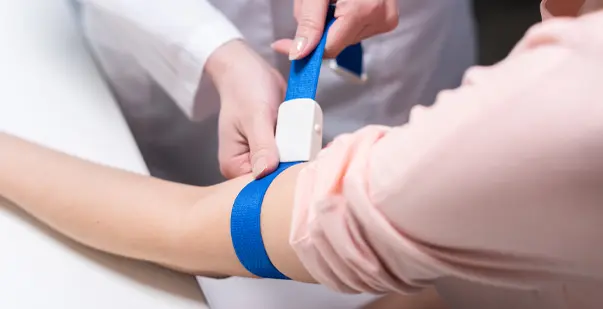Tourniquets are an essential skill that can save lives in emergencies. A tourniquet restricts blood flow to a limb. This prevents excessive blood loss until you can administer professional medical help. Are you a healthcare professional or someone who wants to be prepared for emergencies?
If yes, then understand the techniques and steps to avoid complications. Study this blog to apply a tourniquet effectively and safely. People can use tourniquets during emergencies to stop bleeding. They put pressure on blood vessels, limiting how much blood can pass through them. You can master the skill by reading the step-by-step instructions mentioned in this blog.
What is a tourniquet?
A tourniquet helps to stop bleeding from a limb. Other methods, such as direct pressure, are not enough. It is a simple strap or brand which you can tighten around the limb above the injury to cut off blood flow. The purpose of a tourniquet is to control bleeding.
Tourniquets involve traumatic injuries, such as deep cuts. They help prevent life-threatening blood loss, which can occur quickly if a major artery is injured. You can apply the tourniquet to stop blood from flowing to the area. This helps prevent shock or death.
You must use a tourniquet well. If you apply it loosely, it will not stop the bleeding. If applied incorrectly, it can cause damage to the issues, muscles, and nerves. Tourniquets are crucial tools for first aid. However, you should use it only when it is necessary.
When should you use a tourniquet?
You must use a tourniquet in emergencies when you cannot control severe bleeding from a limb using other methods such as elevation or applying direct pressure. It is crucial to understand that using a tourniquet is the last measure, as it involves cutting off blood flow to an entire section of a limb. If not done correctly, it can cause permanent damage to nerves, tissues, and muscles.
Here are a few circumstances when you must use a tourniquet:
Life-threatening bleeding:
When there is bleeding from a wound, especially from a major artery, other methods such as applying pressure or using bandages fail to stop the bleeding. This is seen in traumatic injuries such as shootings or accidents.
Amputations or large open wounds:
If the injury involves complete or partial amputation or a wound is too large to be managed by direct pressure alone, This is when you need a tourniquet, which helps prevent excessive blood loss.
Multiple casualties in high-risk environments:
In situations where there are several injuries or face disaster scenarios, you must apply a tourniquet to stabilize severe bleeding in one patient. This ensures that you can give attention to others who need urgent care.
What are the types of tourniquets?
There are different types of tourniquets that control severe bleeding and restrict blood flow to a limb. They are crucial tools used in emergencies where blood loss needs to be stopped quickly. Understand the types available to choose the right one for the right circumstance. Here are the main types of tourniquets:
Windlass tourniquet:
This is one of the most widely used tourniquets. It comprises a strap and a windlass that is turned to tighten the strap. When you turn the windlass, it increases the pressure on the limb. This cuts off the blood flow. The windlass tourniquet successfully controls severe bleeding and is also used by first responders and military personnel.
Elastic band tourniquet:
This is a simple elastic band that wraps around the limb and creates pressure. It is used in medical settings, such as while drawing blood. It is less effective in life-threatening bleeding situations as it cannot apply the same level of pressure as other types.
Ratchet tourniquet:
It uses a ratcheting mechanism that resembles a zip tie to apply pressure. It is user-friendly, and you can tighten it quickly. This makes it effective for use during emergencies by people with limited training. Its design ensures that the pressure is consistent when applied.
Pneumatic tourniquet:
Pneumatic tourniquets are used in surgical settings. They consist of an inflatable cuff placed around the limb. The air is pumped into it, which compresses the limb and stops the flow. Although this is highly effective, pneumatic tourniquets are not used in emergencies as they are complex.
SAX XT Tourniquet:
This features an auto-locking system, allowing rapid application. The design ensures that the tourniquet is tight without any manual adjustments. This ensures easy application in stressful situations. This is usually used by law enforcement.
Improvised tourniquet:
In situations where a commercial tourniquet is not available, you can make improvised tourniquets such as scarves and belts. However, improvised tourniquets are not that effective and should be your last option. Improvised tourniquets are applied with force to stop bleeding.
How to prepare a tourniquet?
Preparing a tourniquet can ensure that you are ready for any emergency involving bleeding. It is crucial to know the materials you need and how to assemble them properly. Here is how you can prepare a tourniquet:
Steps to prepare a tourniquet:
Preparing a tourniquet can help ensure you are ready for any emergency involving bleeding. It is crucial to know the materials you need and how to assemble them properly to avoid cramping during a crisis. Here are the steps to prepare a tourniquet:
Choose the materials:
When you have a commercial tourniquet, check its condition. For an improvised tourniquet, choose a strong, wide band, such as a scarf, belt, or cloth.
Prepare a windlass:
If you are making an improvised tourniquet, you will need a windlass. This could be a rod or a sturdy stick. This will be used to tighten the tourniquet when it is in place.
Position and pre-tighten the band:
Keep the band ready and position it in a way that you can apply it quickly, such as pre-looping the strap for easy fastening. While using an improvised version, wrap the band around the limb above the wound.
Make sure it is accessible:
Keep it in a location that is easily accessible. Quick access is crucial during emergencies.
Read more: How to Stop Bleeding: A Guide to Stopping Bleeding
How to apply a tourniquet? A step-by-step guide
Applying a tourniquet can feel intimidating. However, when done correctly, it can be the difference between life and death. You must stay calm and follow a clear process. This ensures that bleeding stops right away and does not cause any harm. Use a tourniquet when bleeding is severe and you cannot control it with other methods. Know how to apply a tourniquet:
Assess the situation:
Identify if the bleeding is severe. Check if there are signs of life-threatening bleeding, such as blood coming out of a wound, or if the bleeding would not stop after applying pressure. Before you help others, make sure that you are safe.
Position the tourniquet:
Place the tourniquet about 2 to 3 inches above the wound. Place it over joints such as the knee or the elbow. It is crucial that the tourniquet be placed on a part of the limb where it can compress the arteries to stop the blood flow.
Tighten the tourniquet:
Pull the tourniquet strap tightly before securing it. If you are using a ratcheting tourniquet, tighten or twist the mechanism until the bleeding stops. The limb may naturally change color or experience discomfort. This indicates the tourniquet is working.
Secure the tourniquet:
Once the tourniquet is tight and stops bleeding, lock it in place. For windlass tourniquets, this means securing the rod in the clamp. This makes sure that it does not loosen. For other types, the lightning mechanism is locked, so the pressure stays consistent.
Monitor the victim:
Once you place the tourniquet, note the time and keep the person still. Make sure that help is on the way. Do not remove or loosen the tourniquet. This can cause bleeding.
Get emergency help:
Do not leave tourniquets anywhere for more than two hours. Get medical help as soon as possible. Switch the tourniquet on. You can do this by marketing ’T’ with the time and date on the person’s forehead. This will help the emergency personnel know what to do when they arrive.
These steps ensure that you can act confidently in a high-pressure situation. Practice makes perfect. So consider practicing with a training technique.
What can people use as a tourniquet?
If you do not have a medical tourniquet, you can make one from everyday items. A person needs something that can be wrapped around the skin. This includes:
- Tights, stockings, pantyhose
- A hand or tea towel
- An elastic bandage
- Exercise or resistance bands
- A head wrap or bandana
- Wide plastic tubing
When not to use a tourniquet?
Tourniquets are primary for limb injuries. You cannot use it for head or torso injuries. An injury to the torso or head needs direct pressure with a cloth. This helps slow down or reduce bleeding until emergency help arrives.
Read more: 9 Basic Life-Saving Skills That Will Help You Save A Life
Conclusion
During an emergency, a tourniquet can reduce or stop excessive bleeding. A nurse or doctor may use a tourniquet during procedures, such as inserting an IV line or drawing blood. Always call 911 if a person has excessive bleeding. Apply pressure to try and stop bleeding, as using a tourniquet does not slow the bleeding down. Hence, stay with the person until an ambulance arrives. Help them get emergency assistance when the ambulance is not available. The best way to avoid mistakes is to be informed about when and how to use a tourniquet correctly.









